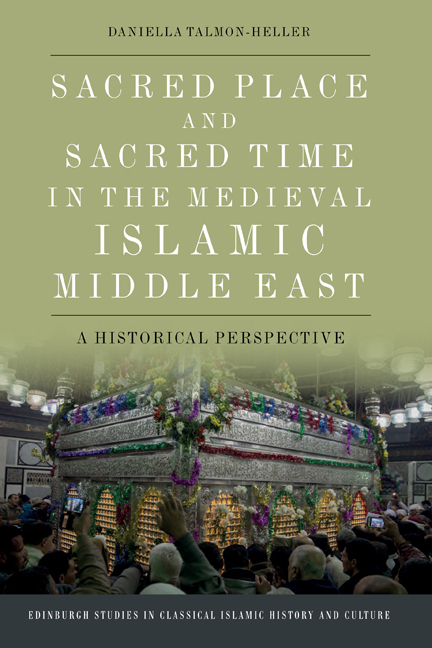Book contents
- Frontmatter
- Contents
- List of Figures
- Acknowledgements
- Map of the Middle East
- Introduction
- 1 Etic Concepts and Emic Terms
- 2 The State of the Art
- Part One A Sacred Place: The Shrine of al-Husayn’s Head
- Part Two A Sacred Time: The Month of Rajab
- Final Comments: Spacial and Temporal Sanctity
- Works Cited
- Index
6 - Why Ascalon? Christian Martyrs and Muslim Murābiṭūn (Defenders)
Published online by Cambridge University Press: 17 October 2020
- Frontmatter
- Contents
- List of Figures
- Acknowledgements
- Map of the Middle East
- Introduction
- 1 Etic Concepts and Emic Terms
- 2 The State of the Art
- Part One A Sacred Place: The Shrine of al-Husayn’s Head
- Part Two A Sacred Time: The Month of Rajab
- Final Comments: Spacial and Temporal Sanctity
- Works Cited
- Index
Summary
‘A long time has passed’, the historian Ibn Fadl Allah al-ʿUmari (d. 749/1349) skeptically remarks, ‘between the killing of al-Husayn and the construction of the [Fatimid] shrine in Ascalon’. Citing the ninthcentury Akhbār al-Dawla al-ʿAbbāsiyya, al-ʿUmari appears to back the theory according to which al-Husayn's head was sent to Medina for re-interment next to his brother al-Hasan. Al-ʿUmari's contemporary, the theologian and jurist Ibn Taymiyya, is more outspoken in his dismissal of the authenticity of the head in Ascalon. He insists that, until the establishment of the mashhad there, more than 430 (hijri) years after the death of al-Husayn, there was no textual or material indication whatsoever – be it on an epigraph, or a pilgrimage account – that the city ever housed the martyr's remains. Therefore, Ibn Taymiyya concludes, it is highly unlikely that al-Husayn's skull was inhumed in Ascalon, of all places.
In the following pages, we will examine the validity of the claim of al-ʿUmari and Ibn Taymiyya via a careful examination of the sources, in an attempt to find an earlier text identifying Ascalon as the hallowed burial place of the head of the martyred al-Husayn. After all, it is plausible that Badr al-Din chose to invest in an already consecrated place. As noted by the anthropologist Michael Sallnow, ‘reenergizing sacred sites and reorienting them to new politico-religious centers’ is a way to extend political control and consolidate it. However, given the lack of textual evidence for a earlier Husayni shrine, we will be obliged to acknowledge that Badr al-Jamali's mashhad is based on an altogether ‘invented tradition’, as defined by Eric Hobsbawm and Terence Ranger. They coined this oxymoron for a new ‘ritual and symbolic complex’, on the basis of the rather recent formulation of a myth presented in the honourable garb of antiquity, feeding a sense of continuity with a significant past. Medieval mentalite was, in general, receptive to the miraculous unearthing of relics and the formation of new cults. Despite the reservations of some scholars, it adopted the discovery of al-Husayn's head and perpetuated its veneration for centuries to come.
- Type
- Chapter
- Information
- Sacred Place and Sacred Time in the Medieval Islamic Middle EastA Historical Perspective, pp. 61 - 69Publisher: Edinburgh University PressPrint publication year: 2020



